Crickets disperse seeds of early-diverging orchid Apostasia nipponica, suggesting an ancient association
by Kobe University
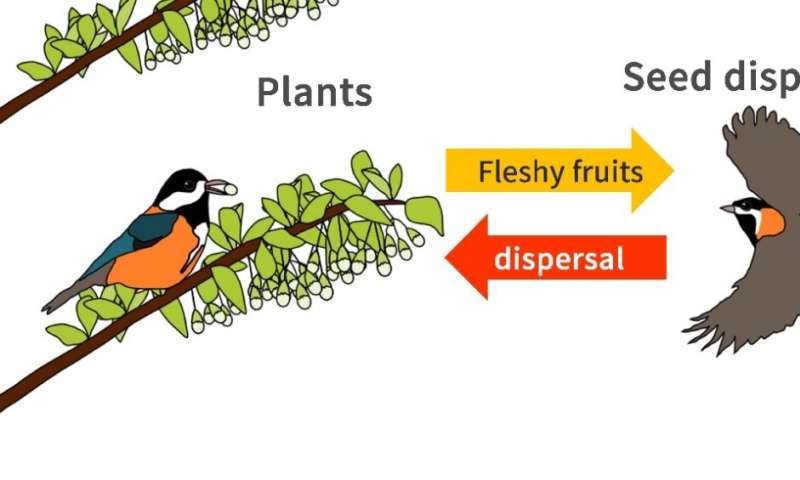
Schematic diagram of internal seed dispersal mutualism: In return for these seed dispersal services, many plants provide nutritional rewards to their seed dispersers in the form of fleshy fruits. Credit: Kenji Suetsugu
Associate Professor Suetsugu Kenji (Kobe University Graduate School of Science) has found unusual seed dispersal systems by crickets and camel crickets in Apostasia nipponica (Apostasioideae), acknowledged as an early-diverging lineage of Orchidaceae. These findings were published on August 11 in the online edition of Evolution Letters.
Seed dispersal is a key evolutionary process and a central theme in terrestrial plant ecology. Animal-mediated seed dispersal, most frequently by birds and mammals, benefits seed plants by ensuring efficient and directional transfer of seeds without relying on random abiotic factors such as wind and water. Seed dispersal by animals is generally a coevolved mutualistic relationship in which a plant surrounds its seeds with an edible, nutritious fruit as a good food for animals that consume it (Figure 1). Birds and mammals are the most important seed dispersers, but a wide variety of other animals, including turtles and fish, can transport viable seeds. However, the importance of seed dispersal by invertebrates has received comparatively little attention. Therefore, discoveries of uncommon mechanisms of seed dispersal by invertebrates such as wetas, beetles and slugs usually evoke public curiosity toward animal-plant mutualisms.

Unlike most plants, all of the >25,000 species of orchids are heterotrophic in their early life history stages, obtaining resources from fungi before the production of photosynthetic leaves. Orchid seeds, therefore, contain minimal energy reserves and are numerous and dust-like, which maximizes the chance of a successful encounter with fungi in the substrate. Despite considerable interest in the ways by which orchid flowers are pollinated, little attention has been paid to how their seeds are dispersed, owing to the dogma that wind dispersal is their predominant strategy. Orchid seeds are very small and extremely light, and are produced in large numbers. These seeds do not possess an endosperm but instead usually have large internal air spaces that allow them to float in the air column. In addition, orchid seeds are usually winged or filiform, evolved to be potentially carried by air currents. Furthermore, most orchid seeds have thin papery coats formed by a single layer of non-lignified dead cells. It has been thought that these fragile thin seed coats cannot withstand the digestive fluids of animals, in contrast to the thick seed coats in indehiscent fruits, which are considered an adaptation for endozoochory.
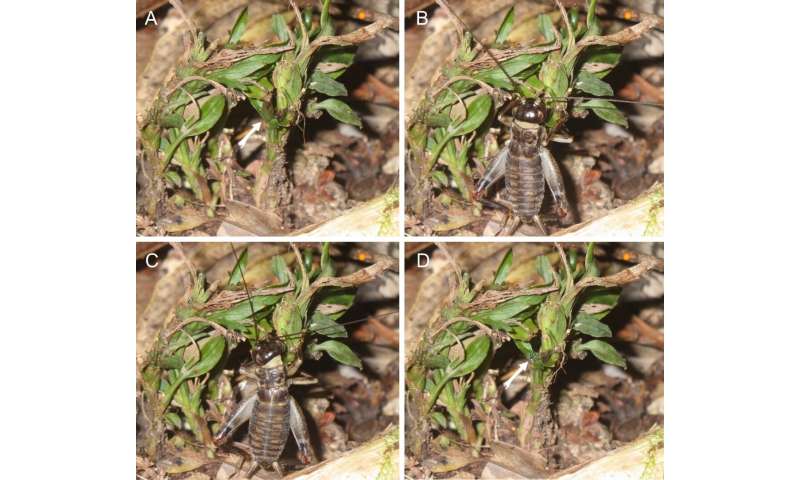 Sequential photographs of the cricket Eulandrevus ivani consuming an Apostasia nipponica fruit (indicated by arrows). An entire fruit was consumed during a single visit by the cricket. Credit: Kenji Suetsugu
Sequential photographs of the cricket Eulandrevus ivani consuming an Apostasia nipponica fruit (indicated by arrows). An entire fruit was consumed during a single visit by the cricket. Credit: Kenji Suetsugu
However, it is noteworthy that the subfamily Apostasioideae commonly has indehiscent fruits with hard, crustose black seed coats. Apostasioids are the earliest-diverging subfamily of orchids and consist of only two genera (Apostasia and Neuwiedia), with only ~20 species distributed in southeastern Asia, Japan, and northern Australia. All Apostasia and most Neuwiedia species investigated to date are known to possess berries with hard seed coats. Apostasioids are also well known for several unique traits, such as a non-resupinate flower with an actinomorphic perianth and pollen grains that do not form pollinia (Figure 2). These have been considered ancestral characteristics in orchids, given that they are similar to those found in the members of Hypoxidaceae (which is closely related to Orchidaceae) family. Similarly, the presence of an indehiscent fruit with a thick seed coat, found in most Apostasia and Neuwiedia species can be an ancestral trait in orchids.

An Apostasia nipponica plant flowering in the wild on Yakushima Island, Japan. Although most orchids have specialized labellum, stamens and pistil fused into a gynostemium and pollen rains unified into pollinia, Apostasia has solanum-type flower with a relatively simple gynostemium with anthers that contain powdery pollen grains. Credit: Kenji Suetsugu
Here, Suetsugu has studied the Apostasia nipponica (Apostasioideae) seed dispersal system in the forest understory of the warm-temperate forests on Yakushima Island, Kagoshima Prefecture, Japan. Consequently, Suetsugu presents the evidence for seed dispersal by crickets and camel crickets in A. nipponica. Similar results were obtained in different years, indicating that this interaction is likely stable, at least in the investigated site. It probably constitutes a mutualism, wherein both partners benefit from the association—orthopteran visitors obtain nutrients from the pulp and A. nipponica achieves dispersal of seeds from the parent plants (Figure 3). The seeds of A. nipponica are coated with lignified tissue that likely protects the seeds as they pass through the digestive tract of crickets and camel crickets.
Although neither the cricket nor camel cricket can fly, they potentially transport the seeds long distances owing to their remarkable jumping abilities. Despite the traditional view that the minute, dust-like, and wind-dispersed orchid seeds can travel long distances, both genetic and experimental research has indicated that orchids have limited dispersal ability; orchid seeds often fall close to the maternal plant (within a few meters), particularly in understory species. Given that A. nipponica fruits are produced close to the ground in dark understory environments where the wind speed is low, seed dispersal by crickets is probably a successful strategy for this orchid.
Orchid seeds lack a definitive fossil record due to their extremely minute size. Therefore, the interaction described here provides some important clues as to the animals that may have participated in the seed dispersal of the ancestors of orchids. Given that the origin of crickets and camel crickets precedes the evolution of orchids, they are among the candidates for seed dispersers of the ancestors of extant orchids. Owing to many plesiomorphic characteristics and the earliest-diverging phylogenetic position, members of Apostasioideae have been extensively studied to understand their floral structure, taxonomy, biogeography, and genome.
However, there is still a lack of information regarding seed dispersal in the subfamily. Therefore, Suetsugu has documented the animal-mediated seed dispersal of Apostasioideae members for the first time. Whether seed dispersal by animals (and particularly by orthopteran fruit feeders) is common in these orchids warrants further investigation. It is possible that this method of dispersal is an ancestral trait in Apostasioideae, given that indehiscent fruits with a hard seed coat are common within the clade. Further research, such as an ancestral character-state reconstruction analysis of more data on the seed dispersal systems of other apostasioids, can provide deeper insights into the early evolution of the seed dispersal system in Orchidaceae.
Explore furtherParasitic plants rely on unusual method to spread their seeds
More information: Kenji Suetsugu, A novel seed dispersal mode of Apostasia nipponica could provide some clues to the early evolution of the seed dispersal system in Orchidaceae, Evolution Letters (2020). DOI: 10.1002/evl3.188
Landmarks facing climate threats could 'transform,' expert says
by Laura Oleniacz, North Carolina State University
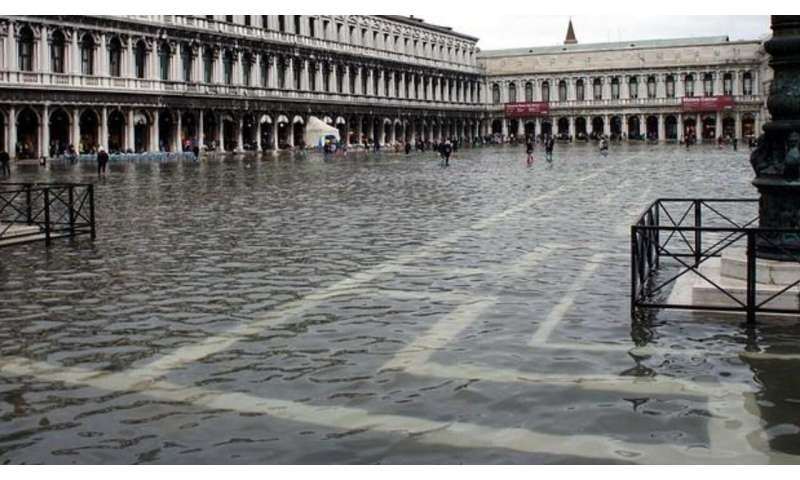
Cropped image of flooding in Venice. Credit: Chris, Flickr: https://www.flickr.com/photos/cr01/. Shared through Creative Commons CC BY-SA 2.0 License: https://creativecommons.org/licenses/by-sa/2.0/.
How much effort should be spent trying to keep Venice looking like Venice—even as it faces rising sea levels that threaten the city with more frequent extreme flooding?
As climate change threatens cultural sites, preservationists and researchers are asking whether these iconic locations should be meticulously restored or should be allowed to adapt and "transform."
"The traditional preservationist paradigm is the idea of static preservation—materials stay in a constant state, and we protect the values identified at the time they were designated," said Erin Seekamp, first author of a paper that raises these questions and a professor of parks, recreation and tourism management at North Carolina State University.
"However, it's really infeasible to manage all heritage sites and property through persistent adaptation due to the extent of projected climate impacts," Seekamp said. "We are arguing for preservationists to shift toward transformation in some cases."
The paper was co-authored by Eugene Jo, World Heritage Leadership Programme Coordinator at the International Centre for the Study of the Preservation and Restoration of Cultural Property (ICCROM).
Seekamp and Jo presented two ideas for how transformation could take place: adaptively in response to climate change impacts, or in advance of anticipated or projected impacts.
Seekamp and Jo argue that some cultural icons "severely impacted" by climate change-related events could remain damaged to serve as a "memory" of that event, and to help communities better understand and learn about the climate-related vulnerabilities of places.
In other cases, they argued that some landmarks at risk of climate change should be allowed to "transform" when the cost of preserving a landmark is too high. Decisions about how these important landmarks can and should change need to be guided by the values of descendants of people and cultures that those sites were originally intended to highlight and preserve, they said.
"Individuals whose heritage is at stake, and who receive benefits from those places as tourist sites, should be part of the discussions about change, and about what preserving values connected with sites should look like," Seekamp said.
Their ideas about transformation were inspired by the concept of resilience in ecology, Seekamp said, in which a landscape can absorb change in response to a disturbance, and populations shift toward a "new state" or reorganize.
"What we're arguing is that the heritage field adopt an ecological framework of resilience to expand the current paradigm of preservation toward transformation to allow for autonomous and anticipatory adaptation to occur," Seekamp said.
They focused their recommendations on cultural landmarks designated as World Heritage Sites, which are landmarks or areas with important cultural, natural or scientific significance that have legal protections through the United Nations Educational, Scientific and Cultural Organization, or UNESCO.
They argued that preservation leaders create a new category for sites facing climate threats called "World Heritage Sites in Climatic Transformation." That list could help gather information and better document sites that face threats from climate change, as well as help channel resources toward them.
"We are argue that policy reform is needed to create the flexibility that would allow for both the continuity of heritage values, and the evolution of place meaning and societal benefits in face of climate change," Seekamp said.
Seekamp also indicated that the new designation could aid a natural landmark like Florida's Everglades National Park. While the park isn't a site recognized for its cultural heritage, which was the focus of Seekamp's viewpoint—it was designated as a World Heritage Site because of its outstanding geologic and natural features—there are material remains of heritage present that are also at risk to rising seas and increasing temperatures.
The park is the traditional lands of the Seminole Tribe of Florida and the Miccosukee Tribe, as well as the Calusa. The designation of the park as a "World Heritage Site in Climatic Transformation" could allow managers to think about alternatives that better integrate culture and cultural values in changing environments, Seekamp said.
"We're not saying that this should open the door for development or tourism," Seekamp added. "We're saying, 'Let's create a new categorization, and enable those places to not just think about persistent adaptation, but about transformative adaptation.' It allows us to think about alternatives."
Explore further
More information: Erin Seekamp et al, Resilience and transformation of heritage sites to accommodate for loss and learning in a changing climate, Climatic Change (2020). DOI: 10.1007/s10584-020-02812-4
Restaurant customers frown on automatic gratuities, particularly after good service
YOU CAN ALWAYS LEAVE A TIP IN CASH OVER AND ABOVE THE GRATUITY ON THE BILL THE CUSTOMER BEING A WORKER IS BEING CHEAP WITH THEIR MONEY, NOT SO; ACTUALLY ITS DOCTORS, LAWYERS, TEACHERS, ETC. AND OTHER PROFESSIONALS by Becky Kramer, Washington State University
 North American customers spend about $66 billion annually on tips at restaurants and other establishments. Credit: Washington State University
Automatic gratuities leave restaurant patrons with a bad taste, even when the meal and the service were excellent, new research from Washington State University indicates.
North American customers spend about $66 billion annually on tips at restaurants and other establishments. Credit: Washington State University
Automatic gratuities leave restaurant patrons with a bad taste, even when the meal and the service were excellent, new research from Washington State University indicates.
"We thought if service quality was high, people wouldn't care if an automatic service charge was added to their bill," said Jeff Joireman, the study's coauthor and professor and chair of the Department of Marketing and International Business at the Carson College of Business.
But whether customers had a good experience or bad one, they reacted negatively when their bill came with a mandatory tip, preventing them from leaving the gratuity themselves. Surprisingly, customers with the best dining experiences expressed the most dissatisfaction with automatic gratuities. The research was published in Journal of Services Marketing and was based on four separate studies."People think non-voluntary tipping systems are unpopular because customers can't punish servers for poor quality service," Joireman said. But when the service was high, "we found that customers were equally frustrated by non-voluntary tipping—this time because they couldn't reward their servers."
In both service scenarios, customers said they were unlikely to patronize the restaurant in the future.
Non-voluntary tipping systems take control away from the customer, said Ismail Karabas, assistant professor of marketing at Murray State University and lead author of the research, which was part of his doctoral dissertation at WSU.
"Being able to reward the server makes customers feel good," Karabas said. "That's part of the restaurant experience."
When customers lose control of the tip, "their ability to show their gratitude has been blocked," he said. "They have fewer positive feelings about the restaurant experience, and they're less likely to eat there again."
Automatic gratuities growing in restaurant industry
North American customers spend about $66 billion annually on tips at restaurants and other establishments. Although voluntary tipping is still standard practice, a growing number of restaurants are moving toward automatic gratuities, Karabas said.
For restaurant owners, the switch to automatic gratuities is often about fairness, he said. They want to divide tips between servers and the kitchen staff, rewarding the entire team and equalizing pay.
"The person who cooks your meal may be working harder than the server, but servers end up making quite a bit more money when you add in the tips," Karabas said. "That's led to turnover of kitchen staff, which is a concern in the restaurant industry."
While the intent of using automatic gratuities to equalize pay and retain employees is laudable, restaurant owners and managers should be aware of the drawbacks, he said.
"High-quality service does not compensate for the negative customer response to a non-voluntary tipping system," Karabas said. "Managers may think 'We're fine as long as we provide good service,' but we found that's just not true."
Exploring other ways to reward good service
PAY THEM MORE
GIVE THEM REGULAR HOURS
AND BENEFITS
Restaurants that switch to automatic tipping could explore other ways to help customers keep their sense of control, the researchers said.
"Based on what we know about blocked gratitude, I would look for ways to give customers the feeling they are still the ones leaving the tip, even though it's added automatically," Karabas said. "It could be as simple as saying, 'You tipped your server 18% today. Thank you.'"
Restaurants could also encourage customers to reward their servers through other means, such as providing feedback on comment cards, voting for a server of the month, or even adding a separate line on the bill for an extra tip, the researchers said.
But restaurants should be careful about perceptions, according to Karabas, who said additional research is needed on alternate ways to reward servers. Some customers might react cynically to an extra line on their bill for an enhanced tip.
"You don't want customers to think you're being sneaky and trying to trick them into tipping twice," he said.
Explore further Servers perceive well-dressed diners as better tippers, study finds
More information: Ismail Karabas et al, The role of blocked gratitude in non-voluntary tipping, Journal of Services Marketing (2020). DOI: 10.1108/JSM-03-2020-0082
Provided by Washington State University
AND HERE IS A SOLUTION
How to boost tips and donations with the dueling preference approach
by Matt Weingarden, American Marketing Association
Researchers from University of Missouri-Kansas City, University of Wisconsin-Milwaukee, and University of Pennsylvania published a new paper in the Journal of Marketing that examines the effectiveness of what they call "the dueling preferences approach" on prosocial giving.
The study, forthcoming in the Journal of Marketing, is titled "Penny for Your Preferences: Leveraging Self-Expression to Encourage Small Prosocial Gifts" and is authored by Jacqueline Rifkin, Katherine Du, and Jonah Berger.
BallotBin, a UK-based company, designs custom bins for the disposal of cigarette butts. These "ballot bins" have a fascinating feature: They pose a question and provide two bin compartments, each labeled with a possible answer to the question. Smokers can then answer the question through the disposal of a cigarette butt into either compartment. For example, one recent "ballot bin" in London asked smokers whether flying or invisibility is the better superpower, allowing them to express their preference by depositing their cigarette butts in one of two labeled compartments. This set-up can be found in a variety of other settings designed to increase prosocial acts. Cafés have started to position two tip jars rather than one, asking patrons whether they prefer Star Trek or Star Wars. Similarly, the ASPCA asked people to donate money by expressing their preference for cats or dogs ("Vote for your Paw-sident").
This set-up, in which the act of giving is framed as a choice between two options, is called the "dueling preferences" approach. But the question remains: Is the dueling preference approach really more effective at increasing prosocial giving than traditional approaches? And if so, why?
The research team set out to answer these questions. They conducted initial experiments in real cafés and with real charities using several different "duels" (summer vs. winter, mountains vs. beach, chocolate vs. vanilla ice cream) and discovered that the dueling preferences approach can indeed be more effective than traditional approaches at increasing small prosocial gifts. In particular, the dueling preferences approach increased people's likelihood to tip/donate and how much money they gave.
Next, the researchers sought to understand why this approach works. Several follow-up studies indicate this approach works because it provides people with the opportunity to say something about who they are. Du explains, "People love to talk about themselves and share their opinions. In fact, the parts of the brain that light up when we get to share our opinions also light up in response to finding $10 or getting a sweet treat. This fact about human psychology ultimately makes the dueling preferences approach an inherently attractive and motivating opportunity. People are willing to give money to share what they believe in."
Of course, the dueling preferences approach must be implemented tactfully. People may be willing to give money to share what they believe in, but what if a duel captures an issue people don't believe in? As Rifkin described, "When we tested a duel that asked people's preferences for the letter "A" vs. "B"—a relatively uninspiring issue—we were not able to increase prosocial giving. Similarly, when we tested a duel that was interesting to some, but not to all—one's preference for pets—we found that the duel only increased giving among those who found the issue to be important to them. Also, people do not always want or even need to express themselves." While the inherent need to say something about who we are is critical for harnessing the power of dueling preferences, people differ in what and when they want to share. As a result, it takes some thought to figure out exactly what options to choose, when, and among whom to deploy this approach.
Overall, those interested in increasing prosocial giving can benefit by leveraging the flexibility and ease of implementation of the dueling preferences approach. Ultimately, if managers can effectively harness people's desire to express themselves, this approach can be a powerful tool for increasing prosocial giving. The magic of dueling preferences lies in its ability to leverage any valued identity—whether a Star Trek fan, chocaholic, or lefty—to increase prosocial giving.
Explore further
Successful school instruction is digital—but not exclusively
by Technical University Munich

Credit: CC0 Public Domain
Secondary school students perform better in natural sciences and mathematics and are more motivated when digital tools are used in instruction. However, success depends on the design of the tools used. Success levels are higher when children and young adults do not study alone and when digital instruction is accompanied by paper-based teaching materials, according to the conclusion reached by one of the largest investigations on the topic, evaluating approximately 90 individual studies.
Digitalization of school instruction has been hotly debated for years. What programs should teachers use on the computer, when and how often? The debate is characterized by a challenging abundance of research projects. The Center for International Student Assessment (ZIB) at the Technical University of Munich (TUM) has now evaluated a total of 92 studies published worldwide since the year 2000.
The meta-study shows that secondary school students in classes which work with digital teaching tools perform better than children and young adults in classes that are taught solely on a traditional basis. Furthermore these students are more motivated by the respective subject. This applies for all grades in secondary schools and for all the subjects investigated, i.e. mathematics, biology, chemistry and physics.
However, digital tools alone are no guarantee of success. Their impact on performance depends on how they are used in instruction:
Children and young adults benefit more from digital teaching tools when they work together in pairs instead of alone. The researchers assume that computer programs play a special role in stimulating discussions between the students which can positively impact the learning process.
Secondary school students perform better when accompanied by teachers while working with digital tools. When they work with computer programs entirely alone, the positive effect is minor.
The positive effect of digital tools is greater when the tools do not completely replace classic classroom materials. A promising approach is to use them in supplement to analog methods.
Digital tools increase performance more particularly when teachers have been professionally trained how to integrate them into the lessons.
Not even well-made programs can replace teachers
"Digital tools should be worked into instruction in moderation," says Prof. Kristina Reiss, head of the ZIB and dean of the TUM School of Education. "Getting rid of tried and proven analog formats would be going a step too far. In addition, we see that even very well-made learning programs cannot replace the teacher."
In well-planned application, the advantages of digital tools could be completely leveraged, in particular for complex and abstract content in natural sciences and mathematics, for example the visualization of chemical compounds and geometric shapes.
"If the new teaching methods can additionally increase the motivation of secondary school students, this will be a great opportunity for the STEM subjects," Reiss points out.
Some digital tools are more useful than others
The meta-study also indicates which types of digital tools are most promising. The greatest positive effect comes from what are referred to as intelligent tutor systems, programs which convey content in small units and also enable individual exercises. The decisive factor is that these programs adapt the speed, level of difficulty and amount of assistance to the user's skills. On the other hand, hypermedia systems configured for free exploration with video, audio and text materials that fail to define a learning objective are comparatively less effective.
Explore furtherRemote learning tough for teachers working from home with many clocking extra hours, survey finds
More information: Delia Hillmayr et al, The potential of digital tools to enhance mathematics and science learning in secondary schools: A context-specific meta-analysis, Computers & Education (2020). DOI: 10.1016/j.compedu.2020.103897
Provided by Technical University Munich
New study warns: We have underestimated the pace at which the Arctic is melting
Credit: CC0 Public DomainArctic sea ice is melting more quickly than once assumed. Today's climate models have yet to incorporate the steep rise in temperatures that have occurred over the past 40 years. This, according to a new study by researchers at the University of Copenhagen and other institutions.Temperatures in the Arctic Ocean between Canada, Russia and Europe are warming faster than researchers' climate models have been able to predict.Over the past 40 years, temperatures have risen by one degree every decade, and even more so over the Barents Sea and around Norway's Svalbard archipelago, where they have increased by 1.5 degrees per decade throughout the period.This is the conclusion of a new study published in Nature Climate Change."Our analyses of Arctic Ocean conditions demonstrate that we have been clearly underestimating the rate of temperature increases in the atmosphere nearest to the sea level, which has ultimately caused sea ice to disappear faster than we had anticipated," explains Jens Hesselbjerg Christensen, a professor at the University of Copenhagen's Niels Bohr Institutet (NBI) and one of the study's researchers.Together with his NBI colleagues and researchers from the Universities of Bergen and Oslo, the Danish Metrological Institute and Australian National University, he compared current temperature changes in the Arctic with climate fluctuations that we know from, for example, Greenland during the ice age between 120,000–11,000 years ago."The abrupt rise in temperature now being experienced in the Arctic has only been observed during the last ice age. During that time, analyses of ice cores revealed that temperatures over the Greenland Ice Sheet increased several times, between 10 to 12 degrees, over a 40 to 100-year period," explains Jens Hesselbjerg Christensen.He emphasizes that the significance of the steep rise in temperature is yet to be fully appreciated. And, that an increased focus on the Arctic and reduced global warming, more generally, are musts.Climate models ought to take abrupt changes into accountUntil now, climate models predicted that Arctic temperatures would increase slowly and in a stable manner. However, the researchers' analysis demonstrates that these changes are moving along at a much faster pace than expected."We have looked at the climate models analyzed and assessed by the UN Climate Panel. Only those models based on the worst-case scenario, with the highest carbon dioxide emissions, come close to what our temperature measurements show over the past 40 years, from 1979 to today," says Jens Hesselbjerg Christensen.In the future, there ought to be more of a focus on being able to simulate the impact of abrupt climate change on the Arctic. Doing so will allow us to create better models that can accurately predict temperature increases:"Changes are occurring so rapidly during the summer months that sea ice is likely to disappear faster than most climate models have ever predicted. We must continue to closely monitor temperature changes and incorporate the right climate processes into these models," says Jens Hesselbjerg Christensen. He concludes:"Thus, successfully implementing the necessary reductions in greenhouse gas emissions to meet the Paris Agreement is essential in order to ensure a sea-ice packed Arctic year-round."Explore further Highest-ever temperature recorded in Norwegian Arctic archipelago
Study finds Americans prize party loyalty over democratic principles
by Yale University
 Credit: CC0 Public Domain
Credit: CC0 Public Domain
It is conventional wisdom that Americans cherish democracy—but a new study by Yale political scientists reports that only a small fraction of U.S. voters are willing to sacrifice their partisan and policy interests to defend democratic principles.
The study, published in the American Political Science Review, found that only 3.5% of U.S. voters would cast ballots against their preferred candidates as punishment for undemocratic behavior, such as supporting gerrymandering, disenfranchisement, or press restrictions.
"Our findings show that U.S. voters, regardless of their party affiliation, are willing to forgive undemocratic behavior to achieve their partisan ends and policy goals," said Milan Svolik, professor of political science in the Faculty of Arts and Sciences and co-author of the study. "We find that polarization raises the stakes of elections and, in turn, the price of prioritizing democratic principles over partisan interests. Voters' willingness to sacrifice democratic principles may not be desirable in terms of protecting democracy, but it has an intuitive political logic: They are trading off one political interest against another."
Svolik and co-author Matthew Graham, a Ph.D. candidate in the Department of Political Science, conducted two experiments. One was an original, nationally representative survey experiment that asked respondents to choose among candidates, some of whom took positions violating key democratic principles. The other was a natural experiment the researchers conducted based on Montana's 2017 special election for the U.S. House of Representatives, in which Republican candidate Greg Gianforte physically assaulted a journalist who had repeatedly asked him a question about health policy on the night before the election.
In the survey experiment, respondents were presented with a series of choices between hypothetical candidates for a state legislature. Candidates were randomly assigned attributes, including race, gender, party affiliation, and positions on economic and social issues. In four of the scenarios, both candidates adopted democratically neutral positions. In seven others, one of the candidates was randomly assigned an undemocratic position, such as support for gerrymandering or ignoring unfavorable court decisions.
Overall, candidates who embraced an undemocratic position lost about 11.7% of their vote share. This may have been exacerbated by the randomized nature of the experiment, which assigned some hypothetical candidates highly unlikely attributes, such as a Democrat who supports tax cuts for the wealthy. When the researchers focused on choices respondents were more likely to encounter in the real world because candidates' adopted conventional positions for their respective parties, they found that just 3.5% of respondents would vote against their partisan interests to protect democratic principles. This reflects the consequences of political polarization, said the researchers: When party and policy are closely aligned, opposing candidates become increasingly ideologically distinct from each other, raising the price that voters must pay to punish their preferred candidate for undemocratic behavior by voting for the other candidate.
In 2016, only about 5% of U.S. House district candidates won their seats by a margin of less than 7%—making the potential loss of 3.5% in vote share unlikely to deter candidates from engaging in undemocratic behavior, the researchers said.
"Our findings suggest that in the overwhelming majority of House districts, a majority-party candidate could get away with openly violating a democratic principle," said Graham. "Voters make tradeoffs. For the most part, people support candidates who share their partisan, ideological, or policy goals, even if that means condoning undemocratic behavior."
When Gianforte body-slammed a reporter in his campaign office the night before Montana's 2017 congressional election, more than half of voters had already cast absentee ballots. This allowed the researchers to compare votes cast for the same pair of candidates before and after the election-eve assault. In politically moderate precincts, voters who cast ballots on Election Day punished Gianforte for the assault on the journalist by voting across party lines. In hardline Republican precincts, significantly fewer voters punished Gianforte for his undemocratic behavior on Election Day, according to the study.
The researchers assert that their findings expose a blind spot in conventional methods of measuring support for democracy, which often involve asking people questions like: "Democracy may have problems, but it is better than any other form of government. To what extent do you agree or disagree with this statement?"
"Conventional measures don't capture people's willingness to act on their commitment to democratic values when doing so is politically costly," Svolik said. "If, as we found, only a small percentage of voters are willing to punish undemocratic behavior by their favored candidates in one of the world's oldest democracies, then we shouldn't be surprised by voters' failure to stop aspiring autocrats in younger democracies like Turkey, Hungary, or Venezuela."
Explore further Would you vote for a Democrat who behaves like a Republican?
More information: Matthew H. Graham et al, Democracy in America? Partisanship, Polarization, and the Robustness of Support for Democracy in the United States, American Political Science Review (2020). DOI: 10.1017/S0003055420000052
Journal information: American Political Science Review
Provided by Yale University
Forest growth in drier climates will be impacted by reduced snowpack, study finds
by Portland State University

A high-density ponderosa pine forest at the Fort Valley Experimental Forest site near Flagstaff, Arizona. Credit: Kelly Gleason | Portland State University
A new study suggests that future reductions in seasonal snowpack as a result of climate change may negatively influence forest growth in semi-arid climates, but less so in wetter climates.
Researchers from Portland State University, U.S. Geological Survey, U.S. Forest Service and the universities of Vermont and Maine found that forest density and snowpack can influence drought stress and forest growth in ways that are important to recognize for managing forests in a changing climate.
Research sites included pine-dominated experimental forests in northern Arizona, South Dakota, and northern Minnesota.
The study—led by Kelly Gleason, assistant professor of ecohydrology at PSU—found that forest growth in water-limited, dryland areas is likely to be most dramatically impacted by snowpack reductions. In these semi-arid climates, reduced snowpack may negatively influence forest growth and may increase tree mortality. This was only exacerbated in high-density forests.
"Forests are a lot more vulnerable because of increasing density," Gleason said. "More trees are sharing the same amount of water, and there's less water over time because of climate change impacts."
She said that in arid climates like much of the western U.S. where water availability is driven by snow, reducing forest density through thinning will improve the resilience of these forests amid a changing climate.
By contrast, the study found that in wetter climates like Minnesota, reduced snowpack as a result of future warmer winters may positively influence forest growth, potentially by extending the growing season. The study found that in these forests, thinning would have less of an impact on the snowpack-growth relationship.
Explore further Snowpack declines may stunt tree growth and forests' ability to store carbon emissions
More information: Kelly E. Gleason et al, Forest density intensifies the importance of snowpack to growth in water‐limited pine forests, Ecological Applications (2020). DOI: 10.1002/eap.2211
'I can't afford tuition': College students face financial strains, health concerns from pandemic ahead of fall semester
by Jessica Menton, Usa Today

Credit: CC0 Public Domain
Brittany Goddard's final semester at Howard University isn't the dream ending she imagined in Washington, D.C.
When the coronavirus pandemic shut down the U.S. economy in March, she scrambled to pack up her belongings since she had to be out of her dorm room within 48 hours. At the same time, she lost her part-time job at a catering company and still hasn't received unemployment after filing for jobless benefits in April.
She was set to study abroad in Barcelona over the summer, but those plans were upended due to the pandemic. And with just weeks to go before the fall semester begins, she's worried about how she'll pay the remaining balance of her tuition and fees—roughly $9,000—since her financial aid won't cover it at the private school.
"It's heartbreaking. I'm a low-income student. I can't afford tuition," Goddard, 20, says, who's created a GoFundMe page to raise money since her mother doesn't have the means to take out another Parent PLUS Loan, a federal student loan available to parents of dependent undergraduate students.
"We don't have much," Goddard says. "My mom is a single parent putting two kids through college alone. I'm trying to make it through the final stretch."
Colleges brace for stagnant enrollment
Millions of students across the country, like Goddard, face financial strains and health fears as they decide whether to return to colleges and universities this fall. It comes at an unpredictable time for faculty and parents as policymakers in Washington grapple with further coronavirus outbreaks, leaving schools rushing to implement plans for the new academic year.
Just over a third of college students will return to campus and attend class in-person this fall if given the option, according to a new report from Student Loan Hero, which was given exclusively to U.S. TODAY. Another 16% still plan to return to campus, but will take courses online, while roughly 29% plan to study online from home, the data shows.
While many students plan to take advantage of online learning options this fall, they don't necessarily think their courses should cost as much as in-person classes. Almost 66% of students think remote classes are of lower quality than those held in person, and that tuition costs should be reduced accordingly, data from Student Loan Hero shows.
In the fall, Fitch Ratings forecasts that annual enrollment declines could range from 5% to 20% for many colleges and universities as a result of the pandemic. Private colleges could experience more meaningful financial effects than public colleges, given a higher reliance on tuition and student fee revenues, for which the median share of total revenue is 82%, compared with 38% for rated public universities, according to Fitch Ratings.
Tuition constraints threaten to exacerbate the financial effects of enrollment declines, experts say. The economic downturn could weaken expected family contributions and endowments, and increase financial aid needs.
Enrollment pressures related to a drop in international students and incoming freshmen will affect some institutions more so than others, experts say. For instance, private colleges in competitive regions with challenging demographics like in the Northeast will likely be among those most affected. But other schools with a wider geographic draw are poised to be less vulnerable.
Along those lines, Harvard recently acknowledged in an email to faculty and staff that more than 20% of its students do not intend to enroll this fall, according to a report in the Harvard Crimson.
Parents worry about financial aid, housing costs
Across the country, Jennifer Degutis, 48, has mixed feelings about sending her son, Ryan Contreras, 19, back to school for his sophomore year at the University of California, San Diego.
Contreras, an aerospace engineer major, will have his classes online this semester, Degutis says. But his housing options are up in the air if he doesn't return this fall. He was guaranteed housing on campus for his first two years with his financial aid package, but if he comes back in the spring, he'll be put on a wait list, she says.
He would need to remain on campus since he doesn't have a car, and they still don't know whether he'll be paired with a roommate yet. The price of a single room was too expensive with rising costs, and they would have to pay fees for him to use the campus facilities even if he stayed home, she says.
When students arrive at the university this month, they will find coronavirus testing stations strategically planted throughout campus.
"It's nerve wracking to know he's going back to school in this chaos," says Degutis, who's a retail manager at Five Below, a discount store. She lives nearly three hours away from the school in La Quinta, California.
A work-study program is also part of his financial aid package, but there aren't many options and she's unsure of how he'll be able to work in the library or in dining halls due to social-distancing measures.
Just over 46% of student workers are very concerned they won't be able to work during the fall semester, according to Student Loan Hero. And only about 1 in 5 students say their college offered a price cut for the fall semester due to the pandemic.
Mental health is a priority for parents
Not only has the pandemic created financial headaches for parents and students, but it also threatens to affect their children's mental well-being, Degutis cautions.
"All of my son's classes are online, so my concerns as a parent are also about his mental health if he's confined to his dorm room for 12 weeks," says Degutis.
Tracy Kapiloff, 54, of Houston, Texas, agrees. She is worried about sending her daughter, Andie Kapiloff, 19, back to an out-of-state school in a few weeks.
Her daughter, a sophomore at Swarthmore College, a private, liberal arts college in Pennsylvania, is studying political science and is also on the women's lacrosse team. But athletics are halted for now, and she'll be living alone on campus this year, Kapiloff says.
"I'm concerned about her mental health. Do you want your kid living in a single room, taking online classes while not seeing any friends? Plus the high cost of education. Is it worth it?" says Kapiloff, who is paying about $73,000 per year in tuition, fees and living costs.
"But then you think about her staying home indefinitely and not having any interaction with friends or teachers, so it seemed worse to remain at home."
The school is planning to intermittently conduct group testing for the virus throughout the semester. If a student is positive, they'll test each person individually with a lower, nasal swab, she says.
"It's weird. You send your kids to college sometimes worried about a big social scene. But now there's no parties or alcohol with the pandemic," says Kapiloff. "My concern is her education. But her concern is being social and navigating the new normal on campus."
An increasing number of colleges are offering students a choice of online or in-person classes. About 45% of the college students polled by Student Loan Hero say they plan to take classes online in the upcoming semester.
Some students fear on-campus classes
This fall, Garrett Weed, 22, will finish his last semester as a marketing major at Georgia State University in Atlanta. But he's concerned about how the school will prevent further outbreaks, he says.
He's scheduled to take four courses this semester. One is online, but he hasn't received guidance about the other three. He's worried that he'll have to commute on campus and risk contracting the virus, he says.
"It's scary. This doesn't seem like the smartest thing to do," says Weed. "I'd prefer if all classes were online."
Students' primary concern is avoiding the coronavirus, according to Student Loan Hero. The next two major worries on the list were not learning as much due to online classes and not having the college experience they wanted in terms of social life and extracurriculars.
Weed, who worked part-time at Bartaco, a casual, street-food restaurant, lost his job in the spring. He filed for unemployment in April and didn't get his first check until June, he says.
Since the spring, he's been socially distancing with his family, who live about 45 minutes outside of Atlanta. He eventually moved out of his apartment at the end of July since he couldn't afford rent. He's also run into challenges trying to get an internship since many places aren't hiring, he added.
"It's scary to go that long with no source of income," says Weed, who has a mix of scholarships and student loans to pay for school. This semester was the first time that he had to pay his remaining balance—$200—out of pocket. He normally would receive a refund to help cover a portion of his living expenses, he says.
"It's frustrating not being fully independent. There aren't jobs readily available for me to apply for," says Weed. "When I graduate, I want to get a decent job. An internship would help out so much, but I don't know if I'll be able to now."
Others haven't retrieved their belongings from the spring
Goddard, who is a double major in political science and Spanish at Howard University, stashed her belongings in storage in the spring, expecting to return to school in the fall. But now she's finishing her final months as an undergraduate living at home in Atlanta, Georgia, and doesn't know when she'll be able to return to get her stuff.
She opted to stay with her mother since her financial aid and lack of income couldn't cover her living expenses on campus.
She attended Howard University, a historically Black college and university, for the experience to be around a diverse group of young adults. Although the school is reopening in the fall, there won't be a homecoming, football games or double-dutching on campus this semester, she says.
"I'm devastated. College is the most transformative years of your life. Things are never going to be the same," Goddard says. "I wanted to go out with a bang, but COVID ruined it."
Explore further Harvard invites freshmen to campus, but classes stay online
©2020 USA Today
Distributed by Tribune Content Agency, LLC.
Road test: Chinese 'robotaxis' take riders for a spin
by Beiyi Seow, Dan Martin

Chinese players such as Baidu, Alibaba-backed AutoX and ride-sharing king DiDi Chuxing recently launched autonomous taxi pilot projects in cities around the country
Chinese entrants in the race to put autonomous vehicles on the road are bringing "robotaxis" online in hopes that a hired-car format can be the key to unlocking wide acceptance of the futuristic technology.
It is expected to be years before cars that operate completely without human intervention are unleashed owing to lingering technological, regulatory, and safety hurdles.
But as China challenges US tech dominance, Chinese players such as Baidu, Alibaba-backed AutoX and ride-sharing king DiDi Chuxing recently launched autonomous taxi pilot projects in cities around the country.
Similar efforts are under way in the US, and AutoX's chief executive Xiao Jianxiong told AFP the first fully-autonomous vehicles could be on the roads by the end of the year.
Robotaxis or delivery services are considered ideal for accumulating the driving time and huge data cache needed for cars to "learn" and become safe enough.
Chinese consumers—known for eagerly embracing e-commerce, online payments and other digital solutions—are lining up for a spin in DiDi Chuxing's self-developed autonomous taxis at a Shanghai pilot project launched in June.
Underlining the work-in-progress nature of the concept, a DiDi staffer occupies the driver's seat, ready to take the wheel if needed.
But Da Xuan, a 24-year-old social-media worker, leapt at a taste of the future.
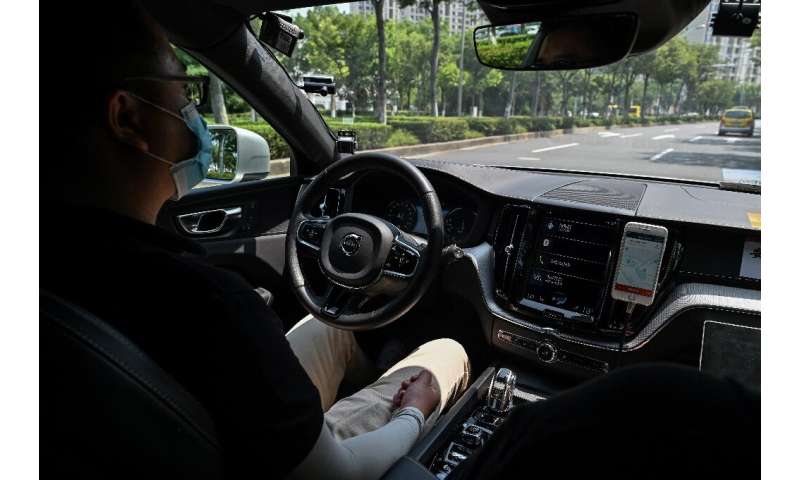
Robotaxis or delivery services are considered ideal for accumulating the driving time and huge data cache needed for cars to 'learn' and become safe enough
'Smooth' running
"I heard companies like Uber or Tesla were doing autonomous driving, so I was curious what Chinese companies were doing, whether they can go into production, and if so, what will the (riding) experience be like," she said.
"It was very smooth," Da said, adding that she would feel safe in such a car.
Test subjects use DiDi's mobile app to plot a ride through suburban roads in a Volvo fitted with a crown of tech hardware topped by a spinning radar device.
The vehicle confidently sets out, accelerating, braking, signalling and turning on its own in real traffic as a female voice calmly narrates: "Yielding for crosswalk"; "Your car has been disinfected".
When a large truck abruptly swerved in front, DiDi's AI driver smoothly applied the brake.
Like any student driver, however, it still needs practice.
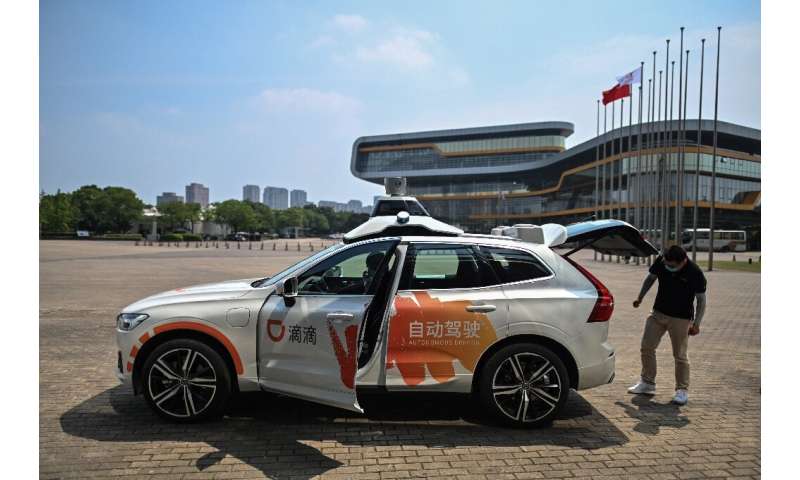
Chinese consumers—known for eagerly embracing e-commerce, online payments and other digital solutions—are lining up for a spin in DiDi Chuxing's self-developed autonomous taxis at a Shanghai pilot project launched in June
At one stop sign, it braked so abruptly that passengers lurched forward.
And any impromptu deviation from the plotted route requires human intervention.
But Meng Xing, chief operating officer of DiDi's autonomous driving company, told AFP its AI system "is already smart enough to handle most of the situations", and safety drivers almost never need to touch the steering wheel or brakes.
Tesla chief executive Elon Musk, known for his overly rosy predictions, raised eyebrows in July by saying the US electric carmaker could have a completely autonomous car ready this year, which analysts have dismissed.
'Long way' to go
Paul Lewis, who heads policy research at the Washington-based non-profit Eno Center for Transportation, told AFP that hopes are being "reset" as the pace of the technology's development disappoints.
"Technology developers are starting to realise the limits of artificial intelligence and the benefits of the human brain in handling some of these tasks," he said, adding we remain "a long way" from driverless cars.
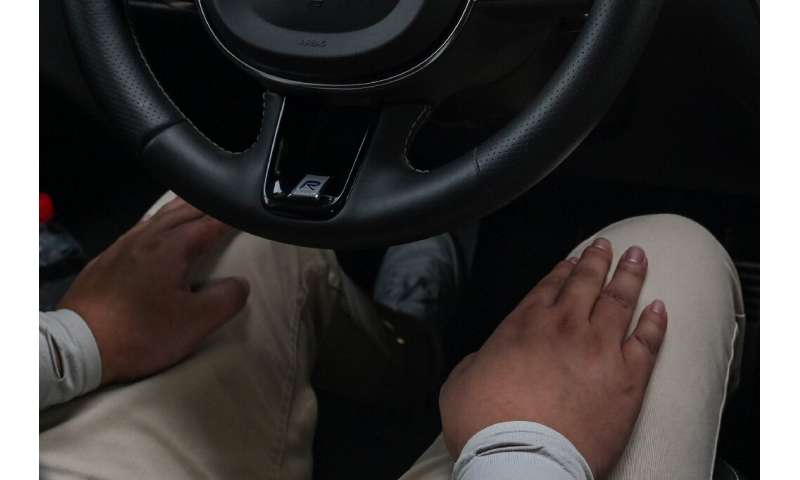
A Didi executive said in June that the ride-hailing giant aims to operate more than a million self-driving cars by 2030
But Xiao of AutoX expects a "sizeable" deployment of the vehicles—without safety drivers—could take place in two to three years, with regulations and technology being the main obstacles.
"It's just a matter of time and effort to make it happen," he said. "There are no open scientific questions left to be solved."
Tech giant Baidu has plans for autonomous car testing bases in more than 10 Chinese cities including Beijing, with a 45-strong robotaxi fleet already on trial in central China's Changsha city, plying an area of around 130 square kilometres (50 square miles).
Its Apollo Park in the capital, which opened this year, has more than 200 vehicles while Apollo general manager Li Zhenyu told employees in a letter that "the era of unmanned driving in traffic will definitely arrive".
A Didi executive said in June that the ride-hailing giant aims to operate more than a million self-driving cars by 2030.
"What we are trying to solve is the last 0.5 percent of problems... we believe in the future, we'll be able to get to that point where we can provide a safer experience than a human driver."
Explore further China's Didi launches Silicon Valley research hub
© 2020 AFP
Renewables in Europe: Land requirements can be reduced at low cost
by Institute for Advanced Sustainability Studies e.V.

Credit: CC0 Public Domain
Transitioning our energy supply from coal, oil and gas to wind and solar power is feasible. However, renewables require more land than conventional forms of energy generation. A new study explores the options to reduce the land requirements of a fully renewable energy supply in Europe and their possible impact on the cost of electricity.
The most affordable option for a fully renewable electricity supply in Europe is based on solar parks and onshore windfarms. However, this solution requires some 97,000 km2 land, or roughly 2% of the total area of the European Union—an area equivalent to the size of Portugal.
Offshore wind and solar energy can reduce land requirements
Wind and solar farms change landscapes and their development is frequently the subject of controversy. This is especially true in the case of onshore windfarms, currently the most important technology behind the European energy transition, as these occupy large areas and are visible from a long distance. Prioritizing the adoption of other electricity generation infrastructures in the future could reduce the space requirements of a fully renewable electricity system. According to the study, three options could be pursued individually or in combination to achieve this goal: Offshore wind power, large solar parks, and roof-top solar systems. Each of these technologies could limit land use to about 48,000 square kilometers—one percent of the area of Europe—or even less.
Additional costs are low
According to the study, offshore wind power is particularly cost-effective and could reduce onshore land requirements by 50 percent at an additional cost of five percent compared to the cheapest option. Replacing onshore wind farms with large solar parks or roof-top solar systems would incur additional costs of up to 20 percent. "We have to decide, as a society, how much we value open land," explains the study's author Tim Tröndle. The well-planned expansion of offshore wind power and solar energy offers opportunities to effectively reduce onshore land requirements at a low additional cost.
Explore further Renewables now EU's biggest source of electricity: study
More information: Tim Tröndle et al, Supply-side options to reduce land requirements of fully renewable electricity in Europe, PLOS ONE (2020). DOI: 10.1371/journal.pone.0236958
Journal information: PLoS ONE
Provided by Institute for Advanced Sustainability Studies e.V.


 Sequential photographs of the cricket Eulandrevus ivani consuming an Apostasia nipponica fruit (indicated by arrows). An entire fruit was consumed during a single visit by the cricket. Credit: Kenji Suetsugu
Sequential photographs of the cricket Eulandrevus ivani consuming an Apostasia nipponica fruit (indicated by arrows). An entire fruit was consumed during a single visit by the cricket. Credit: Kenji Suetsugu


 North American customers spend about $66 billion annually on tips at restaurants and other establishments. Credit: Washington State University
North American customers spend about $66 billion annually on tips at restaurants and other establishments. Credit: Washington State University









